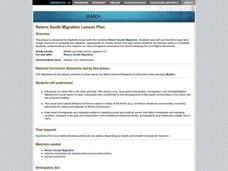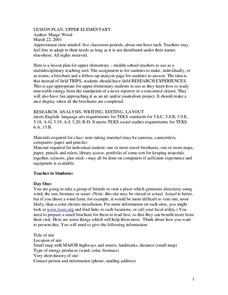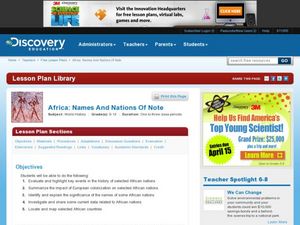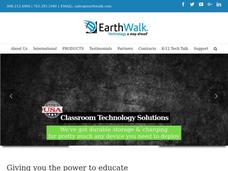Curated OER
Return South Migration Lesson Plan
Learners study the reasons so many immigrants returned to the South following the Civil Rights Movement. They examine how the former slaves influenced the cultural life in the Northern cities.
Curated OER
Renewable Energy
Students identify how to study renewable energy from the standpoint of a news reporter or a concerned citizen. Then they approach art in a fun way through a journalism project that includes create a brochure for display. Students also...
Curated OER
Great North
Students view a video about the Arctic Circle, North Pole and Northern Europe. They locate areas using a map. They create a drawing of the countries where the Inuit live.
Curated OER
The Accuracy of Climate Data
Students use maps to determine how accurate climate data really is. They also answer questions using a table of data.
Curated OER
Competing National Stories in Tibet
Students research the Tibetan conflict from the point of view of both Tibet and China. They review resources produced by both factions and then apply these skills to consider other competing national stories.
Curated OER
A Share in America
Students examine map - reflect on why English colonist kept coming to America (scarcity of land in England / seemingly endless land in America)
Recite line from English poem. They discuss English attitude towards Indians and their lands.
Curated OER
Parthenon
Ninth graders explore he purposes of the Parthenon. In this World History instructional activity, 9th graders create a complete picture of the Parthenon. Students research one aspect of the structure and report their findings back to...
Curated OER
When Civilizations End
Students explore the Forbidden City of ancient China. In this world history lesson, students examine China's history and its dynasties. Students research symbols embedded in China's Forbidden City.
Curated OER
Africa: Names and Nations of Note
Students explore Africa. In this global studies activity, students research the history of African nations, noting the impact of European colonization and other historical events. Students design posters about the nations they research.
Curated OER
Operation Anitbody
High schoolers identify the types of cells that are important in the immune system. They investigate the different mechanisms used by white blood cells as they protect the body from foreign invaders. Students are given five case...
Curated OER
The Grand Canyon
Students investigate how dams help and hurt the ecology of an area. In this Grand Canyon activity, students research the Glen Canyon Dam and why it flooded in 1996. Students create a pros and cons list about dams and write a summary.
Curated OER
Human Genome Project
Students examine the goals of the Human Genome Project. They research issues of the project such as scientific, potential and ethical implications of the project. In addition, they create a presentation to present their findings.
Curated OER
Earthquakes: Learn From the Past, Prepare for the Future
Students examine the destruction caused by earthquakes. In this community safety lesson, students examine the risk involved in living in an earthquake zone and how to prepare for future earthquakes.
Curated OER
Earthquakes: Getting Ready For The Big One
Learners devise a plan to prepare a city for an earthquake. In this lesson on earthquakes, students differentiate between the different types of earthquakes, examine the impact they can have on a city, and write a proposal on how to...
Curated OER
Geograophy of Mexico And Central America
Students create a chart comparing the terrain, climate, economy, environmental issues and natural disasters for Mexico and the Central American countries. They view and discuss a video on the region then compile research on the internet.
Curated OER
Charge and Defeat
Pupils discuss traditional tools used by historians and archaeologists. They conduct a debate on the advantages and disadvantages of rewriting the past and discuss which side of the debate has the strongest case.
Curated OER
Washington D.C.
Students research monuments in Washington, D.C. In this geography lesson, students research one monument and use the Internet to gather information. Students create a three-dimensional model of their monument.
Discovery Education
Sonar & Echolocation
A well-designed, comprehensive, and attractive slide show supports direct instruction on how sonar and echolocation work. Contained within the slides are links to interactive websites and instructions for using apps on a mobile device to...
University of Wisconsin
BEAM: Background, Exhibit, Argument, Method
Thinking of assigning a research paper? Get writers off on the right foot with a instructional activity that introduces the BEAM research model. Writers brainstorm the background of their topic, explicate the aspects of their topic,...
Curated OER
Trash Talkin
Young scholars investigate recycling at several scales, including local, state, national and global. They become aware of recycling, re-use, reduce efforts and policies. Students read the article Where Does Your Garbage Go. They look up...
Curated OER
Weather Forecasting
Students examine cold, warm, and stationary fronts. They also examine the roles of relative humidity and the way air masses move. They are to create forecasts based on the information they collect. Tapes are shared with the class.
Curated OER
Puerto Rico: The 51st State?
Students examine the political status of Puerto Rico. In this global studies lesson plan, students explore Puerto Rico and consider the feelings of Puerto Ricans regarding their unique political status.
Curated OER
Where Life Is Too Short
Students predict how a pandemic would affect aspects of South Africa's society. In this world issues and geography lesson plan, students read a letter outlining the problems affecting South Africa. Students discuss and analyze how...
Curated OER
What I Did On My Summer Vacation
Students use the internet to research the location of their summer vacation trip. Given the demographics, they plot the location on a world map. They create a brochure using the information they collected. Using PowerPoint, they develop...

























